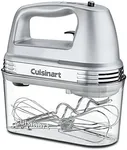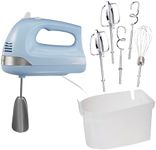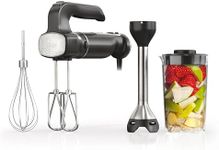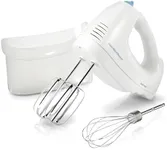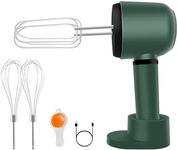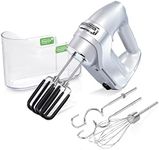Buying Guide for the Best Beginner Mixer
Choosing the right mixer can make a big difference in your cooking and baking experience. Whether you're a beginner or an experienced cook, understanding the key specifications of mixers will help you make an informed decision. Here are some important factors to consider when selecting a mixer that best fits your needs.Type of MixerMixers come in two main types: hand mixers and stand mixers. Hand mixers are portable and great for small tasks like whipping cream or mixing batter. Stand mixers are more powerful and can handle heavier tasks like kneading dough. If you plan to do a lot of baking or need to mix large quantities, a stand mixer might be the better choice. For occasional use or lighter tasks, a hand mixer should suffice.
Power (Wattage)The power of a mixer is measured in watts and indicates how strong the motor is. Higher wattage means the mixer can handle tougher tasks and larger quantities without straining. For basic mixing and light tasks, a mixer with 200-300 watts is usually sufficient. For more demanding tasks like kneading dough, look for a mixer with at least 400 watts. Consider what types of recipes you'll be making most often to determine the appropriate power level.
Speed SettingsMixers come with different speed settings, allowing you to control how fast or slow the beaters move. More speed settings provide greater flexibility for different tasks. Basic mixers may have 3-5 speeds, while more advanced models can have up to 10 or more. If you plan to use your mixer for a variety of tasks, look for one with multiple speed options. For simple tasks, fewer speeds may be sufficient.
AttachmentsAttachments can greatly expand the functionality of your mixer. Common attachments include beaters, dough hooks, and whisks. Some stand mixers also offer additional attachments like pasta makers or meat grinders. Consider what types of tasks you'll be performing and choose a mixer that comes with the appropriate attachments. For basic mixing, standard beaters and a whisk should be enough. For more specialized tasks, look for a mixer with a variety of attachments.
Bowl CapacityThe bowl capacity of a mixer determines how much you can mix at one time. Hand mixers typically don't come with a bowl, so you'll use your own. Stand mixers come with a bowl, and capacities can range from 3 to 7 quarts. For small batches or occasional use, a smaller bowl (3-4 quarts) should be sufficient. If you plan to bake large batches or cook for a crowd, a larger bowl (5-7 quarts) will be more convenient.
Ease of CleaningCleaning your mixer can be a hassle, so it's important to consider how easy it is to clean. Look for mixers with detachable parts that are dishwasher safe. Stand mixers with a tilt-head design can make it easier to access the bowl and beaters for cleaning. Consider how often you'll be using the mixer and how much time you're willing to spend on cleanup when making your choice.
Durability and Build QualityA well-built mixer will last longer and perform better over time. Look for mixers made with high-quality materials like stainless steel and heavy-duty plastic. Read reviews to get an idea of the mixer's durability and reliability. If you plan to use your mixer frequently, investing in a durable model will save you money in the long run. For occasional use, a less expensive model may be sufficient.
